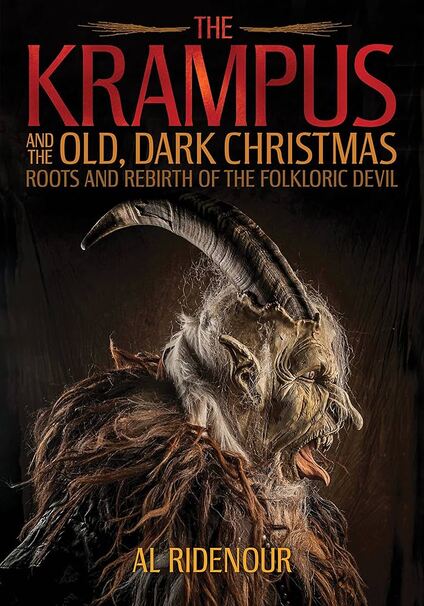
TITLE: The Krampus and the Old Dark Christmas
AUTHOR: Al Ridenour
PUBLISHER: Feral House
ISBN: 978-1627310345
PODCAST EPISODE: Episode 50: Perchten
REVIEWER: Hilary Wilson
Over the past decade, whenever the holiday season rolls around, Santa Claus isn’t the only figure on people’s minds. Now, more than ever, another force has begun to assert itself in the Western world. Some view him as more authentic to the holiday tradition, citing Santa Claus’s current incarnation as a pale imitation of St. Nicholas spun by advertisers at Coca-Cola. Some view him as a dark mirror to Santa Claus, serving as a modern connection to the wild, dark, and pagan past that has been all but forgotten. Whatever the reason, no one can deny that now, whenever December rolls around, Krampus is coming.
Al Ridenour is thoroughly fascinated with this modern preoccupation with Krampus. He endeavors, over many years of research, to get to the bottom of just where Krampus came from. The culmination of this study is THE KRAMPUS AND THE OLD DARK CHRISTMAS: ROOTS AND REBIRTH OF THE FOLKLORIC DEVIL (2016, Feral House). This is not only the most thorough investigation into Krampus’s history in the English language, but also one of the only book-length treatments on the figure.
Ridenour’s research into the history of Krampus is remarkably thorough. He travels to Austria and interviews the people who take place in modern Krampuslaufen, as well as their mask makers. He looks at the history of Krampus through an anthropological lens as well as a folkloric one, and investigates why the idea of being hit with a switch holds such strong appeal. We learn about Krampus’s role in society, which has been perverted in American imagination from that of disciplinarian and servant of St. Nicholas, to an anti-Santa of sorts meant only for horror. Ridenour leaves no stone unturned, and follows the roots of Krampus back not to Nordic folklore, as many do, but rather to Italian, Greek, and even Swiss tradition.
Ridenour’s analysis is dense, and rewards multiple readings. The text is complemented with gorgeous photographs from both modern Krampus and Perchta costumes and parades, as well as historical ones. There are also stunningly detailed photos of the masks throughout. The book exists as a record of folkloric tradition that is quickly changing in the modern world. This is a wonderful book that will delight anyone curious about the resurgent tradition.
AUTHOR: Al Ridenour
PUBLISHER: Feral House
ISBN: 978-1627310345
PODCAST EPISODE: Episode 50: Perchten
REVIEWER: Hilary Wilson
Over the past decade, whenever the holiday season rolls around, Santa Claus isn’t the only figure on people’s minds. Now, more than ever, another force has begun to assert itself in the Western world. Some view him as more authentic to the holiday tradition, citing Santa Claus’s current incarnation as a pale imitation of St. Nicholas spun by advertisers at Coca-Cola. Some view him as a dark mirror to Santa Claus, serving as a modern connection to the wild, dark, and pagan past that has been all but forgotten. Whatever the reason, no one can deny that now, whenever December rolls around, Krampus is coming.
Al Ridenour is thoroughly fascinated with this modern preoccupation with Krampus. He endeavors, over many years of research, to get to the bottom of just where Krampus came from. The culmination of this study is THE KRAMPUS AND THE OLD DARK CHRISTMAS: ROOTS AND REBIRTH OF THE FOLKLORIC DEVIL (2016, Feral House). This is not only the most thorough investigation into Krampus’s history in the English language, but also one of the only book-length treatments on the figure.
Ridenour’s research into the history of Krampus is remarkably thorough. He travels to Austria and interviews the people who take place in modern Krampuslaufen, as well as their mask makers. He looks at the history of Krampus through an anthropological lens as well as a folkloric one, and investigates why the idea of being hit with a switch holds such strong appeal. We learn about Krampus’s role in society, which has been perverted in American imagination from that of disciplinarian and servant of St. Nicholas, to an anti-Santa of sorts meant only for horror. Ridenour leaves no stone unturned, and follows the roots of Krampus back not to Nordic folklore, as many do, but rather to Italian, Greek, and even Swiss tradition.
Ridenour’s analysis is dense, and rewards multiple readings. The text is complemented with gorgeous photographs from both modern Krampus and Perchta costumes and parades, as well as historical ones. There are also stunningly detailed photos of the masks throughout. The book exists as a record of folkloric tradition that is quickly changing in the modern world. This is a wonderful book that will delight anyone curious about the resurgent tradition.